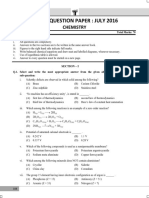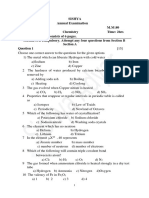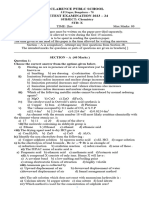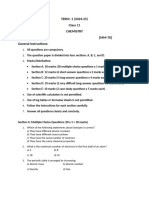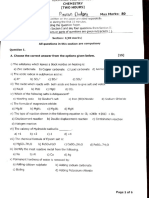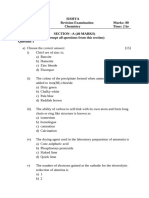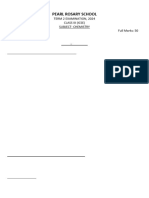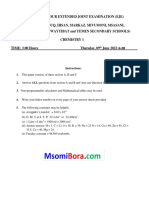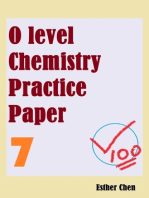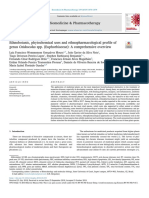This Question Paper Contains 2 Printed Pages
This Question Paper Contains 2 Printed Pages
Uploaded by
Shrijeet BaguiCopyright:
Available Formats
This Question Paper Contains 2 Printed Pages
This Question Paper Contains 2 Printed Pages
Uploaded by
Shrijeet BaguiOriginal Title
Copyright
Available Formats
Share this document
Did you find this document useful?
Is this content inappropriate?
Copyright:
Available Formats
This Question Paper Contains 2 Printed Pages
This Question Paper Contains 2 Printed Pages
Uploaded by
Shrijeet BaguiCopyright:
Available Formats
SALT LAKE SCHOOL
ANNUAL EXAMINATION, 2022
SUBJECT – CHEMISTRY
CLASS VII
Full marks : 40 Writing time : 1hr
Uploading time : 15 mins
Read all the instructions given in each question carefully.
Answer all questions
1. Name the following : (Do not copy question)
a) A tetraatomic element.
b) The inert gas used in observation balloons.
c) The metal used in galvanisation.
d) A non-metal that is a good conductor of electricity.
e) The Latin name of sodium.
f) The term given to positively charged ions.
g) The catalyst used in the manufacture of ammonia by the reaction between nitrogen and hydrogen.
h) The formula of the ore of zinc.
i) The metal that is not a solid at room temperature.
j) The uncharged subatomic particle. (10)
2. Fill in the blanks by choosing only one word/phrase from those given within brackets:
(Rewrite the sentences with your chosen option and underline that)
a) The correct formula of blue vitriol is _________________ (CuSO4.5H2O / FeSO4.7H2O / ZnSO4.7H2O).
b) ZnCO3 → ZnO + CO2
This reaction is an example of _______________ (combination / decomposition / displacement) reaction.
c) The gas that causes greenhouse effect is ___________ (CO2 / SO2 / NO2).
d) The colour of flame when calcium burns in oxygen is ____________ (golden yellow / lilac / brick red).
e) The type of reaction where heat is absorbed is called ______________ (exothermic / endothermic /
photochemical) reaction.
f) The colour of copper carbonate is ____________ (black / green / white).
g) The formula of rust is ______________ (Fe(OH)3 / Fe2O3 / Fe2O3.xH2O).
h) The chemical name of the compound Sal Ammoniac is _______________ (sodium chloride / ammonium
chloride / ammonium carbonate).
i) The formation of gas bubbles in a liquid during a chemical reaction is called ____________ (precipitation
/ effervescence / residue).
j) Metallic oxides dissolved in water produce ________________ (acids / alkalis / salts).
(10)
3. Choose only one correct option:
• Do not copy question.
• Write only the letter of the correct option.
• Do not copy the corresponding word/phrase of the option.
• Giving multiple letters(options) / overwriting will be treated as wrong answer.
27 are:
i) The number of protons and neutrons in 𝐴𝑙13
A) Protons = 13 ; neutrons = 27 B) protons = 27 ; neutrons = 13
C)Protons = 13 ; neutrons = 14 D) protons = 13 ; neutrons = 13
ii) The number of electrons in S2- (atomic number 16) is:
A) 16 B) 18 C) 14 D) 32
iii) An element has electronic configuration 2,8,6. Its valency is:
Page 1 of 2
This question paper contains 2 printed pages
A) 6 B) +2 C) -2 D) 2
iv) FeSO4 + NaOH → Fe(OH)2 + NaCl
The correct number that is to be placed before NaOH to balance this equation is :
A) 1 B) 2 C) 3 D) 4
v) Sodium is burnt in oxygen. The observation is:
A) Golden yellow flame B) Lilac flame
C)Blue flame D) white fumes
vi) A positive catalyst -----------
A) Does not affect the rate of the reaction
B) Increases the rate of the reaction
C) Decreases the rate of the reaction
D) None of the above
vii) The metal that is below hydrogen in the activity series is:
A) Fe B) Zn C) Pb D) Cu
viii) Sodium has electronic configuration 2,8,1. Identify the CORRECT STATEMENT about sodium:
A) Na gains 1 electron to form cation.
B) Na loses 1 electron to form cation.
C) Na gains 1 electron to form anion.
D) Na loses 1 electron to form anion.
ix) Which one among the following is a metalloid?
A) Silver B) Nitrogen C) Arsenic D) Carbon
x) Which among the following is a metallic method of preventing rusting:
A) Oiling B) enameling C) chrome plating D) painting (10)
4. a) Answer the following questions based on lab preparation of oxygen from H2O2:
i)Give the balanced equation.
ii) Mention the catalyst.
iii) Give the observation.
iv) How is the gas collected? (4)
b) Give chemical formula of the following compounds:
i)Ammonium sulphate ii) Aluminium oxide iii) Calcium phosphate (3)
c) Mention two factors essential for rusting. (1)
d) Give the electronic configuration of the following:
i)K (atomic number 19) ii) P (atomic number 15) (2)
Page 2 of 2
This question paper contains 2 printed pages
You might also like
- Polymeric Foams Innovations in Processes, Technologies, and Products (T.L)Document405 pagesPolymeric Foams Innovations in Processes, Technologies, and Products (T.L)RobEllie100% (1)
- CL 8, T2, SampleDocument9 pagesCL 8, T2, Samplemanasvimathur.vbNo ratings yet
- Jan 2024(2)Document9 pagesJan 2024(2)diajain0301No ratings yet
- Alphonsa School, Kalamjote - Preboard - ChemistryDocument4 pagesAlphonsa School, Kalamjote - Preboard - Chemistryakshayashivakumar96No ratings yet
- Delhi Public School Newtown SESSION: 2021-22 Final Term Examination Class: Ix Total Marks: 80 Subject: Chemistry Time: 2 HoursDocument7 pagesDelhi Public School Newtown SESSION: 2021-22 Final Term Examination Class: Ix Total Marks: 80 Subject: Chemistry Time: 2 HoursSAMPURNA GHOSHNo ratings yet
- X Chem Revision IDocument9 pagesX Chem Revision IAmogh PandeyNo ratings yet
- ICSE 10th Mock Test PaperDocument7 pagesICSE 10th Mock Test PaperDeepika100% (1)
- cc096197-5708-402d-9e96-657016968643_Gr9_Chemistry_Term_1_QP_2023-2024_Document7 pagescc096197-5708-402d-9e96-657016968643_Gr9_Chemistry_Term_1_QP_2023-2024_11 Shravani Kore 7ANo ratings yet
- G 8 Annual Exam 22-23Document7 pagesG 8 Annual Exam 22-23sabeena aarizNo ratings yet
- Board Question Paper: July 2016: ChemistryDocument4 pagesBoard Question Paper: July 2016: ChemistryCutry CarryNo ratings yet
- G-9 Term 3Document6 pagesG-9 Term 3vinodtapre25No ratings yet
- Chem TestDocument5 pagesChem Testpra satNo ratings yet
- CHEMISTRYDocument5 pagesCHEMISTRYcharlesmasamaki529No ratings yet
- Chemistry VII 1st Term 2014-154563Document6 pagesChemistry VII 1st Term 2014-154563JoannNo ratings yet
- Icjechpu 07Document11 pagesIcjechpu 07diajain0301No ratings yet
- Grade 10 Chem Term 1 MS 2024 25Document6 pagesGrade 10 Chem Term 1 MS 2024 25nishitrathore100No ratings yet
- St. Paul'S Academy: Purba BardhamanDocument3 pagesSt. Paul'S Academy: Purba BardhamanBHRAMAR DHARANo ratings yet
- Thakur International ChemDocument7 pagesThakur International Chemarmaankasliwal10No ratings yet
- Gr. 8 - Chemistry - 25th Feb.Document6 pagesGr. 8 - Chemistry - 25th Feb.Anuradha DhavalaNo ratings yet
- Class X_Chemistry Preboard AK_2024Document15 pagesClass X_Chemistry Preboard AK_2024weirdsttuffNo ratings yet
- NSM School Chem Prelim 1 2024-25Document8 pagesNSM School Chem Prelim 1 2024-25SusanNo ratings yet
- mcq3 - D27 Sep 2024Document24 pagesmcq3 - D27 Sep 2024tirthsherathiyaNo ratings yet
- Hiranandani Foundation Chem X FPEDocument6 pagesHiranandani Foundation Chem X FPEaldriclawrence8No ratings yet
- ChemistryDocument4 pagesChemistrykaviraj.naidu848No ratings yet
- Chemistry 2022Document4 pagesChemistry 2022New Prestige WelfareNo ratings yet
- Karnataka Icse Schools Association: SECTION A (40 Marks)Document6 pagesKarnataka Icse Schools Association: SECTION A (40 Marks)Arebal100% (2)
- ICSE X SP 03 (Questions)Document10 pagesICSE X SP 03 (Questions)aadithlamjonlNo ratings yet
- SCi 8Document12 pagesSCi 8radivyapriyaNo ratings yet
- Chem PaperDocument4 pagesChem PaperKeertana SN100% (1)
- Chemistry 9th II TermDocument3 pagesChemistry 9th II TermSK GADDAMNo ratings yet
- ICSE Class 10 Chemistry Previous Year Question Paper 2010Document8 pagesICSE Class 10 Chemistry Previous Year Question Paper 2010Samiksha Chettri100% (1)
- Practice Final ExamDocument29 pagesPractice Final ExamMonessa Kaye GomezNo ratings yet
- Chemistry Mid-Term Test April 2024Document6 pagesChemistry Mid-Term Test April 2024abdulsamadm1982No ratings yet
- Chemistry Class 9 2nd Term Question PaperDocument5 pagesChemistry Class 9 2nd Term Question Paperroblox dude ibbuzummerNo ratings yet
- CHEM 1405 Practice Exam 2Document7 pagesCHEM 1405 Practice Exam 2Rebecka BarryNo ratings yet
- Wa0005.Document7 pagesWa0005.Divij DubeNo ratings yet
- Chemistry - 9 Time: 2 Hours M.M. 80: Section I (40 Marks) Attempt All Questions From This SectionDocument4 pagesChemistry - 9 Time: 2 Hours M.M. 80: Section I (40 Marks) Attempt All Questions From This SectionGreatAkbar1No ratings yet
- ICSE X SP 05 (Questions)Document9 pagesICSE X SP 05 (Questions)aadithlamjonlNo ratings yet
- Chemistry Bihar BoardDocument67 pagesChemistry Bihar Boardaarushtripathi750No ratings yet
- Chemistry Exam Term 3 EOT Form 4Document19 pagesChemistry Exam Term 3 EOT Form 4nisaa wilsonNo ratings yet
- Topper 8 110 2 2 Chemistry 2008 Questions Up201506182058 1434641282 7298Document7 pagesTopper 8 110 2 2 Chemistry 2008 Questions Up201506182058 1434641282 7298Manohar GarimellaNo ratings yet
- Class 11 Chem (1)Document4 pagesClass 11 Chem (1)MUSIC IS LIKE MAGICNo ratings yet
- Chem MT-2 Grade IX 24-25Document4 pagesChem MT-2 Grade IX 24-25Rashmi KanojiaNo ratings yet
- Adobe Scan 09 Sept 2024Document6 pagesAdobe Scan 09 Sept 2024jnehaaNo ratings yet
- ICSE Class 10 CHEMISTRY Previous Year Question Paper 2016Document7 pagesICSE Class 10 CHEMISTRY Previous Year Question Paper 2016Madhu SudanNo ratings yet
- 23-24 X Chem JMLDocument8 pages23-24 X Chem JMLarnvt2601No ratings yet
- Grade 10 Revision QPDocument9 pagesGrade 10 Revision QPceemjbbiqedlvjnvunNo ratings yet
- 12th Chemistry 2020Document4 pages12th Chemistry 2020VISHWARAJ MALAVENo ratings yet
- President'S Office Regional Administration and Local GovernmentDocument4 pagesPresident'S Office Regional Administration and Local GovernmentHashir SaidNo ratings yet
- President'S Office Regional Administration and Local GovernmentDocument4 pagesPresident'S Office Regional Administration and Local GovernmentHashir SaidNo ratings yet
- 9 Icse Chem Term=2 EditedDocument2 pages9 Icse Chem Term=2 EditedSubhasree TapaderNo ratings yet
- ChemistryDocument4 pagesChemistrysonigarg1984No ratings yet
- ICSE Board PAPER 2016 CHEMISTRYDocument7 pagesICSE Board PAPER 2016 CHEMISTRYMaria Kanwal Maria KanwalNo ratings yet
- 116180HSSC IichemistryDocument2 pages116180HSSC IichemistryMughal usmanNo ratings yet
- Eje Islamic f4 22 Chem 1-1Document7 pagesEje Islamic f4 22 Chem 1-1Nassrah JumaNo ratings yet
- 10th Chemistry Sample Paper 2Document7 pages10th Chemistry Sample Paper 2GURANSH DEEPNo ratings yet
- Science Class X Chapter 01 Chemical Reaction and Equations Practice Paper 01 2024Document4 pagesScience Class X Chapter 01 Chemical Reaction and Equations Practice Paper 01 2024darshbatra.inNo ratings yet
- Diploma 1 Sem Applied Chemistry 103 n Jun 2021Document3 pagesDiploma 1 Sem Applied Chemistry 103 n Jun 2021amitkrsarkar1972No ratings yet
- Chem MT-2 Grade IX 24-25 Set ADocument4 pagesChem MT-2 Grade IX 24-25 Set ARashmi KanojiaNo ratings yet
- Chemistry Prefinal PaperDocument4 pagesChemistry Prefinal Paperkuldeep9034.patelNo ratings yet
- SG Iron Foundry Process ParametersDocument2 pagesSG Iron Foundry Process Parameterspawarsanjeev85No ratings yet
- INT2010 Practice ExamDocument12 pagesINT2010 Practice ExamAren EiríksdóttirNo ratings yet
- Sec 1 Science SA1 Serangoon Garden Sec 2018Document38 pagesSec 1 Science SA1 Serangoon Garden Sec 2018FaiqahNo ratings yet
- Davi's Cutting FluidsDocument16 pagesDavi's Cutting FluidsAyibagebra Ebunoluwa TogunNo ratings yet
- Material Safety Data Sheet - Natural GasDocument7 pagesMaterial Safety Data Sheet - Natural Gasratna afifahNo ratings yet
- Transformer Ageing4Document2 pagesTransformer Ageing4amulya sNo ratings yet
- Alkaline Body BalanceDocument16 pagesAlkaline Body BalancecarzhallNo ratings yet
- Hyperion TDS 1034Document1 pageHyperion TDS 1034varunchNo ratings yet
- Tyco Grinnell Resilient Seat ButterflyDocument8 pagesTyco Grinnell Resilient Seat ButterflySergio Gana GonzalezNo ratings yet
- CRE - Fluid-Fluid ReactionDocument43 pagesCRE - Fluid-Fluid Reactionandono kusuma jati100% (1)
- MSDS Vansoil 150Document7 pagesMSDS Vansoil 150Maria Angelica Gomez PintoNo ratings yet
- What Is Produced Water and How It Is TreatedDocument5 pagesWhat Is Produced Water and How It Is TreatedRizwan FaridNo ratings yet
- Which of The Following Statements Is Correct During The Electrolysis of A Caustic Soda Solution... - MyschoolDocument9 pagesWhich of The Following Statements Is Correct During The Electrolysis of A Caustic Soda Solution... - MyschoolijuptilpillarNo ratings yet
- Esacote Pu 73: Technical Data SheetDocument2 pagesEsacote Pu 73: Technical Data SheetShambhatiaNo ratings yet
- Metco SF Alum. Wire 10-009Document3 pagesMetco SF Alum. Wire 10-009Remco Van Den BergNo ratings yet
- Meyer, 1941, Old Herb Doctor - TextDocument103 pagesMeyer, 1941, Old Herb Doctor - TextAmberNo ratings yet
- 1 s2.0 S0753332218348157 MainDocument10 pages1 s2.0 S0753332218348157 Mainxavier bioNo ratings yet
- Product List (2022-2023)Document22 pagesProduct List (2022-2023)Creeper TechnologiesNo ratings yet
- Papers 11 20 PDFDocument113 pagesPapers 11 20 PDFYasir ButtNo ratings yet
- Ketone BodiesDocument16 pagesKetone BodiesAsim Ali100% (1)
- MSDS - 97043-00000 - 1736G Curing AgentDocument13 pagesMSDS - 97043-00000 - 1736G Curing AgentGanesh R NairNo ratings yet
- Safety Data Sheet: 1. IdentificationDocument10 pagesSafety Data Sheet: 1. IdentificationBogdan NgrNo ratings yet
- Failure Analysis For Endineering MaterialsDocument18 pagesFailure Analysis For Endineering MaterialsArielle Joyce de JesusNo ratings yet
- Lux Table Illumination LevelDocument16 pagesLux Table Illumination LevelrackpopstoreNo ratings yet
- Design of Steel Earthing Grids in IndiaDocument9 pagesDesign of Steel Earthing Grids in Indiacamono2000No ratings yet
- MRSL 3.0 - December 2022Document8 pagesMRSL 3.0 - December 2022Anggit AdiyanaNo ratings yet
- OMEGA AIR-Compressed Natural Gas Filtration - 950074Document16 pagesOMEGA AIR-Compressed Natural Gas Filtration - 950074Junaid AhmedNo ratings yet
- Testing Method For Automotive Paint: Nissan Engineering StandardDocument164 pagesTesting Method For Automotive Paint: Nissan Engineering StandardJose BresciaNo ratings yet
- Denso-Archco-381 High-Gloss-Hybrid-TopcoatDocument4 pagesDenso-Archco-381 High-Gloss-Hybrid-TopcoatBenjamin AmezquitaNo ratings yet









